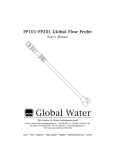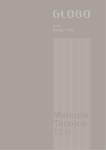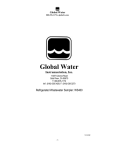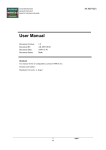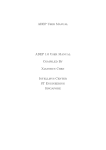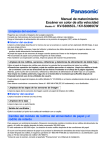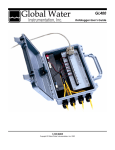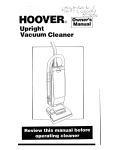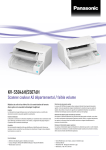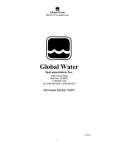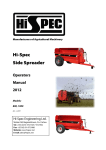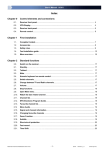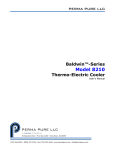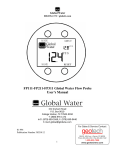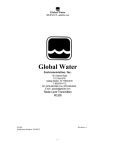Download SS101 Stormwater Sampler - Global Water Instrumentation, Inc.
Transcript
SS101 Stormwater Sampler User’s Manual Global Water The Leader in Water Instrumentation Visit Our Complete Online Catalog www.globalw.com • Call (800) 876-1172, 7:30 AM to 4 PM Pacific Time International: US (916) 638-3429 • FAX: (916) 638-3270 • E-mail: [email protected] 11257 Coloma Road, Gold River CA 95670 USA Level • Flow • Samplers • Water Quality • Weather • Remote Monitoring • Control Contents Specifications 1 Product Description 2 Installation 3 Operation 8 Maintenance 10 Troubleshooting 11 Global Water Warranty 11 Appendices Regulations Overview A-1 Accessories A-2 Sample Datasheets A-3 Specifications Sample Size: Approximately 2.5 liters. Sample Pump: Flow Rate: 1,000 ml per minute at 4 ft. head. Type: Peristaltic Maximum Lift: 22’ Size: 9" L x 17" W x 22" H Operating Temperature: 0 to 70 deg. C Weight: 22 lbs. (Shipping Weight 24 lbs.) Materials: Enclosure: Expanded UV protected PVC Bottle: 4000 ml polyethylene Sample Tubing: Polyethylene Logic Timer/Controller: CMOS Solid State (fully potted in epoxy). Water Sensors: Solid State with a 15’ cable. Sample Hose: 15' nylon reinforced 1/4" ID polyethylene flexible tubing sections with intake strainers. Hoses may be extended, as required, using standard 1/4" tubing and fittings to a maximum of 50’ Battery: Rechargeable 5 AH Gel Cell. Battery charger included. Battery Life: The battery will power the sampler for a minimum of four months including five 24-hr. storm events before recharging is required. SS101 - 1 Global Water Instrumentation, Inc. www.globalw.com • (800) 876-1172 • US (916) 638-3429 • FAX: (916) 638-3270 • E-mail: [email protected] Product Description The Global Water SS101 Stormwater Sampler is easily installed near any storm water channel and can store water samples throughout a storm event. The Sampler takes a discrete sample in one bottle based on rainfall accumulation and/or rise in storm water level. The Global Water SS101 Stormwater Sampler consists the following parts to ensure a successful sampling program: Rugged, rainproof, lockable carrying enclosure Control panel enclosed logic regulator Peristaltic Sampling Pump Bypass plug Bottle cap with float switch and lead 2.5 gallon polyethylene sample bottle Rechargeable 5 AH gel cell battery Battery charger Rain sensor on 15’ cable Water sensor on 15’ cable Removeable sample pickup and debris strainer US Weather Bureau specified rain gauge with mounting bracket and screws 15' nylon reinforced polyethylene sample pickup hose SS101 - 2 Global Water Instrumentation, Inc. www.globalw.com • (800) 876-1172 • US (916) 638-3429 • FAX: (916) 638-3270 • E-mail: [email protected] Installation S A M P L I N G L OCATION To meet specific permitting requirements, sampling locations may need to be established and certified by a licensed professional- refer to your permitting requirements prior to establishing a sampling program. An appropriate sampling location will most likely be: • close to a storm water discharge channel or stream, • situated so the rain gauge is away from trees and buildings, and • removed from public areas. Georgia's NPDES Permit Sampling Location Requirements The Permit discusses sampling location requirements for the following construction projects: • For all sites and common developments other than linear construction projects, all waters into which storm water flows, or all storm water channels, or a combination thereof must be sampled. • For linear construction projects, all perennial and intermittent streams and other water bodies shown on a current 7.5 minute USGS topographic map and all other field verified streams, storm water channels, and water bodies must be sampled. However, representative streams, water bodies, and storm water channels may be sampled. SS101 - 3 Global Water Instrumentation, Inc. www.globalw.com • (800) 876-1172 • US (916) 638-3429 • FAX: (916) 638-3270 • E-mail: [email protected] SAMPLING U NIT The sampler should be placed upright (it will not work if placed on its back or side) within 15 feet from both the rain and water sensors (see installation instructions below). The battery lead should be securely fastened to the appropriate connection. To secure the sample bottle: 1) 2) 3) 4) tighten the bottle cap, place bottle into the sampler enclosure, insert end of peristaltic pump hose into hole in bottle cap, and plug the lead from the bottle cap into the “Bottle SW” socket on the control panel. Place sample bottle into the carrying enclosure. Insert end of peristaltic pump hose into the hole in bottle cap. Plug the lead from bottle cap into “Bottle SW” socket. The sampling unit can be secured from vandalism and strong winds by one of the following methods: • mount unit on post and lock closed, • lock closed and chain rugged handle to a solid structure (such as a tree, post, or building), or • enclose and lock unit in a steel electrical box. Lock the carrying enclosure closed to ensure security. The sampling unit can be mounted onto a post. The sampling unit can be chained to a solid structure. SS101 - 4 Global Water Instrumentation, Inc. www.globalw.com • (800) 876-1172 • US (916) 638-3429 • FAX: (916) 638-3270 • E-mail: [email protected] R A I N GA U G E Mount the Global Water Rain Gauge on a post. Ideally, the post should be 4” x 4”. Install or use an existing post that is located conveniently for daily readings. Do not mount the rain gauge near buildings or trees that may prevent rainfall from reaching the gauge. The Rain Gauge should be mounted near eye-level. The top of the rain gauge should be higher than the top of the post. To install the rain gauge: 1) screw the mounting bracket onto the post, making sure the bracket is level, 2) insert the measuring tube into the rain gauge, 3) slide the rain gauge into the mounting bracket, 4) insert the rain sensor to desired rainfall depth (see installation instructions below), and 5) place the top funnel on the unit. Install a 4” x 4” post that is located conveniently for daily readings. Screw the mounting bracket onto the post, making sure the bracket is level. Slide the rain gauge into the mounting bracket. Georgia's NPDES Permit Sampling Requirements According to the Permit, runoff must be sampled for the following events: • First rainfall event greater than or equal to 0.5 inches in 24 hours; • Any rainfall event greater than or equal to 1.0 inches in 24 hours (but only one event per month needs to be sampled until final stabilization); • Any rainfall event greater than or over 2.0 inches in 24 hours until final stabilization; • One rainfall event greater than or equal to 0.5 inches in 24 hours after final stabilization; and • If Best Management Practices have not been properly designed, installed or maintained in accordance with the Permit, any rainfall event greater than or equal to 0.5 inches in 24 hours. SS101 - 5 Global Water Instrumentation, Inc. www.globalw.com • (800) 876-1172 • US (916) 638-3429 • FAX: (916) 638-3270 • E-mail: [email protected] R A I N S ENSOR The rain sensor is used to trigger a sample for specific amounts of rainfall accumulation. Based on your application’s requirements, insert the tip of the rain sensor into the rain gauge at a specified rainfall accumulation (0.1 to 0.6, 1.0, or 2.0 inches). Securely hook the rain sensor’s cable into the groove in the cylinder and place a tie wrap (provided on the cable) outside the groove to secure the installation. Place the Rain Gauge funnel over the cylinder. Insert the rain sensor’s plug into the “Rain Sensor” socket on the control panel. To trigger a sample when rainfall from 0.1 to 0.6 inch accumulates, insert the sensor at an appropriate depth into the measuring tube (inside cylinder). To trigger a sample when rainfall accumulates at 1.0 or 2.0 inches, insert the sensor at the appropriate depth in the outer cylinder. For your reference, 0.5” is clearly marked on the inside measuring tube, and 1.0” and 2.0” are clearly marked on the outside cylinder. To trigger a sample when rainfall at 0.5 inch accumulates, insert the sensor into the measuring tube (inside cylinder) at the depth as marked. To trigger a sample when rainfall accumulates at 1.0 inch, insert the sensor in the outer cylinder at the depth as marked. Hook the sensor’s cable into the Rain Gauge’s groove, securing a tie wrap outside the groove. To trigger a sample when rainfall accumulates at 2.0 inch, insert the sensor in the outer cylinder at the depth as marked. SS101 - 6 Global Water Instrumentation, Inc. www.globalw.com • (800) 876-1172 • US (916) 638-3429 • FAX: (916) 638-3270 • E-mail: [email protected] P I C K U P H OSE AND WATER S ENSOR The water sensor and pickup hose should be installed in a storm water discharge channel or stream that is appropriate for your sampling program. The water sensor and pickup hose can be installed in the following manner: 1) Securely insert a piece of rebar or similar mounting material into the center of the storm water discharge channel or stream. The material should extend from the bottom of the channel at a distance appropriate for sensor installation (see step 2). Avoid installation where water may pool. 2a) In a dry channel, fasten the water sensor and the end of the pickup hose onto the mounting material using tie wraps, electrical tape, or hose clamps. Ideally, the pickup strainer should be placed at 1/2 the depth of flow during a storm event. The water sensor should be tied just above the debris strainer, in order to trigger a sample after the sample intake is submerged. The water sensor and pickup hose should be situated to avoid contact with the channel bottom. 2b) In a stream, fasten the end of the pickup hose onto the mounting material using tie wraps or hose clamps. The pickup strainer should be submerged under water and should be situated to avoid contact with the channel bottom. For stream sampling (as opposed to dry channel sampling) only the rain sensor will be used to trigger a sample. Securely insert a piece of mounting material into the center of the channel. 3) For dry channel sampling, plug water sensor into “Water Sensor” socket on the control panel. For stream sampling, the bypass plug must be installed in the “Water Sensor” socket. In a dry channel, the water sensor should be tied just above the debris strainer. In a stream, the pickup strainer should be submerged under water. SS101 - 7 Global Water Instrumentation, Inc. www.globalw.com • (800) 876-1172 • US (916) 638-3429 • FAX: (916) 638-3270 • E-mail: [email protected] Operation SAMPLER Verify that the sampling unit, rain gauge, water and rain sensors, and sampling pickup hose are installed correctly (see previous section). The Global Water SS101 Stormwater Sampler will function only if the battery plug is securely fastened into the appropriate socket on the control panel, the bottle plug is inserted into the “Bottle SW” socket, and either: • both the rain sensor and water sensor are plugged into the appropriate sockets on the control panel (i.e., both sensors must be submerged to trigger a sample), or • the rain sensor or water sensor is plugged into its appropriate socket and the bypass plug is inserted into the remaining socket (i.e., only the sensor that is plugged in must be submerged in order to trigger a sample). Sample Now Water Sensor Rain Sensor Bypass Plug Rain Sensor ON/OFF Sampler with both sensors used to trigger a sample Sampler with one sensor used to trigger a sample (bypass plug in use). Turn the sampling unit ON (switch is on the control panel) and verify that the sampler is operating using the “Sample Now” switch. The “Sample Now” switch can also be used to take manual samples. If the “Sample Now” switch does not run the pump, verify that the unit was installed and set up correctly (see above) and that the battery is recharged (see Maintenance section). If the unit still does not sample, refer to the Trouble Shooting section. The unit must be ON to take automatic samples. The sampler will take approximately a 2.5 L sample. The sampler has a backflush function that will clear the pickup hose and pickup strainer after a sample is complete. The float switch in the bottle cap will turn off the sampler before the sample bottle overflows. After a storm, remove the sample bottle or transfer the sample to a small bottle for lab or turbidity meter analysis. Then, install an empty, clean bottle. SS101 - 8 Global Water Instrumentation, Inc. www.globalw.com • (800) 876-1172 • US (916) 638-3429 • FAX: (916) 638-3270 • E-mail: [email protected] R A I N GA U G E The top funnel of the Rain Gauge catches the rain and delivers it to the measuring tube. When over one inch of rain falls before the gauge is emptied, water will spill out of the measuring tube into the outer cylinder. Rainfall of less than one inch can be read directly from the measuring tube by standing the measuring tube on a level surface and reading the amount to the nearest 100th of an inch. This measurement can then be recorded in a rainfall log (sample log provided). For rainfall over one inch, empty the measuring tube containing the first 1.00 inch of rain. Using the top funnel, carefully pour water from the outer cylinder into the measuring tube (if there is more than one inch of rain in the outer cylinder, pour out the measuring tube and repeat). Measure and record the total amount of rainfall, being sure to count the first inch of rain that was in the measuring tube. Place the measuring tube on a level surface and read the rainfall amount to the nearest 100th of an inch. Georgia's NPDES Permit Sampling Requirements As required by the Permit, samples from automatic samplers must be collected no later than the next business day after their accumulation. Rainfall must be measured and recorded every 24 hours. We recommend establishing a convenient time each day to check and collect (if necessary) samples and record rainfall. SS101 - 9 Global Water Instrumentation, Inc. www.globalw.com • (800) 876-1172 • US (916) 638-3429 • FAX: (916) 638-3270 • E-mail: [email protected] Maintenance SAMPLER The Global Water SS101 Stormwater Sampler requires minimal maintenance. The sampler enclosure is rainproof and rugged. Prevent exposure to extremely rough usage. Routinely wipe the carrying case and control panel face, rinse the pickup hose and debris strainer, and wash the sample bottle with mild soap and warm water. Additional plastic and glass sample bottles, norprene tubing for the sampler pump, bottle caps/float switches, removeable debris strainers, sensors, and pickup hose can be purchased from Global Water (see Accessories section). R A I N GA U G E The sampler’s Rain Gauge requires minimal maintenance. Wash the Rain Gauge periodically with mild soap and warm water using a household bottle brush. Do not use solvents or abrasives to clean the gauge and do not wash the gauge in a dishwasher. Do not allow accumulated water to freeze in the gauge and avoid extremely rough usage. B ATTERY The battery will last without requiring recharging through several storm events. If the pump grinds slowly, this is an indication that the battery requires recharging. We recommend fully recharging batteries approximately once per month. In addition, the battery should be recharged before any extended use. To recharge the battery, unfasten it from the control panel, slide it out of the carrying case, and unhook the cord from the battery terminals. Then, fasten the battery charger’s disconnects onto the battery terminals and plug the charger into a wall socket. Full recharge will take about 12 hours. Additional batteries and battery chargers are available from Global Water (see Accessories section). To recharge the battery, fasten the charger’s disconnects onto the battery terminals and plug the charger into a wall socket. SS101 - 10 Global Water Instrumentation, Inc. www.globalw.com • (800) 876-1172 • US (916) 638-3429 • FAX: (916) 638-3270 • E-mail: [email protected] Troubleshooting If your Global Water SS101 Stormwater Sampler does not seem to be functioning properly: • Refer to the manual for proper setup, check all connections and power supplies. Manuals and additional technical information can be viewed on Global Water’s web page (www.globalw.com). • Call Global Water for technical support at (800) 876-1172 or (916) 638-3429 (many problems can be solved over the phone). You can also fax [(916) 638-3270] or e-mail ([email protected]) Global Water a detailed description of problems relating to your product. • If your equipment needs to be returned to the factory for any reason, please call Global Water to obtain a RMA number (Return Material Authorization). Do not return items without a RMA number displayed clearly on the outside of the package. • When contacting Global Water for technical support, please have the following information accessible: Product name and model number Unit serial number Purchase Order Number (if applicable) Global Water invoice number Detailed description of problems relating to the product Global Water Warranty Our goal is to provide you with the finest water instrumentation at a reasonable price. Our products are always fully supported and 100% guaranteed. Global Water warrants that its products are free from defects in material and workmanship under normal use and service for a period of one year from date of shipment from factory. Global Water’s obligations under this warranty are limited to, at Global Water’s option: (i) replacing, or (ii) repairing any products determined to be defective. In no case shall Global Water’s liability exceed the product’s original purchase price. This warranty does not apply to any equipment that has been repaired or altered by anyone but Global Water, or which has been subjected to misuse, negligence, or accident. It is expressly agreed that this warranty will be in lieu of all warranties of fitness and in lieu of the warranty merchantability. SS101 - 11 Global Water Instrumentation, Inc. www.globalw.com • (800) 876-1172 • US (916) 638-3429 • FAX: (916) 638-3270 • E-mail: [email protected] Regulations Overview C O N S T R U C T I O N S I T E S T O R M W A T E R S A M P L I N G: GE O R G I A' S N A T I O N A L P O L L U T A N T D I S C H A R G E E L I M I N A T I O N S Y S T E M ( N P D E S ) PE R M I T1 Georgia's Department of Natural Resources General Permit No. GAR100000 - Authorization to Discharge Under the National Pollutant Discharge Elimination System, Storm Water Discharges Associated with Construction Activity became effective August 1, 2000. The permit strongly encourages the use of automated water sampling equipment. Although it can be used for a variety of applications, the Global Water SS101 Stormwater Sampler was specifically designed to meet Permit No. GAR100000's storm water sampling requirements. The Permit requires that storm water samples2 be taken at construction sites between 5 and 250 acres, as well as at smaller sites that are part of a common development, within 45 minutes following either: • the collection of a specified amount of rainfall after storm water runoff begins; or • the beginning of storm water runoff after the collection of a specified amount of rainfall. The Permit also requires that samples be taken at the following frequency3: • the first rainfall event greater than or equal to 0.5 inches in 24 hours; • any rainfall event greater than or equal to 1.0 inch in 24 hours (but only one 1.0 inch event per month needs to be sampled until final stabilization); • any rainfall event greater than or over 2.0 inches in 24 hours until final stabilization; • one rainfall event greater than or equal to 0.5 inches in 24 hours after final stabilization; and • any rainfall event greater than or equal to 0.5 inches in 24 hour if Best Management Practices have not been properly designed, installed or maintained in accordance with the Permit. In addition, rainfall must be measured and recorded once every 24 hours. The SS101 uses a rain gauge that was developed and is manufactured to United States Weather Bureau specifications. To meet the Permit's sampling requirements, the Global Water SS101 uses two sensors to start an automatic sample: the rain sensor and the water sensor. The sensors can also be used to trigger samples independently. The rain sensor is positioned in a rain gauge and can trigger a sample at 0.5, 1.0, and 2.0 inch rainfall events. The water sensor is positioned in a storm water runoff channel where it will trigger a sample when runoff begins. 1 This information is presented for general application overview only and should not be considered a replacement for fully reading and understanding Permit No. GAR100000 -Authorization to Discharge Under the National Pollutant Discharge Elimination System, Storm Water Discharges Associated with Construction Activity. 2 Storm water discharge sampling locations are identified for each site in a Comprehensive Monitoring Program, prepared and certified by a professional licensed by the State of Georgia. 3 Based on average rainfall in Georgia, it appears that there will be about 12-18 qualifying rainfall events per year. SS101 - A-1 Global Water Instrumentation, Inc. www.globalw.com • (800) 876-1172 • US (916) 638-3429 • FAX: (916) 638-3270 • E-mail: [email protected] Accessories Part Name Part Number Unit Removeable Battery BAT003 Each Battery Charger GB011 Each 1 Gallon Glass Sample Bottle GL066 Each Bottle Cap/Float Switch SS003 Each Rain Gauge SS005 Each Pickup Hose SS017 Per/ft. Removeable Sample Pickup SS025 Each Norprene Peristaltic Pump Tubing SS060 Each Rain and Water Sensors with 15’ Cable SS063 Each 2.5 Gallon Plastic Sample Bottle WS001 Each Please contact Global Water or visit our website (www.globalw.com) for unit prices. SS101 - A-2 Global Water Instrumentation, Inc. www.globalw.com • (800) 876-1172 • US (916) 638-3429 • FAX: (916) 638-3270 • E-mail: [email protected]


















